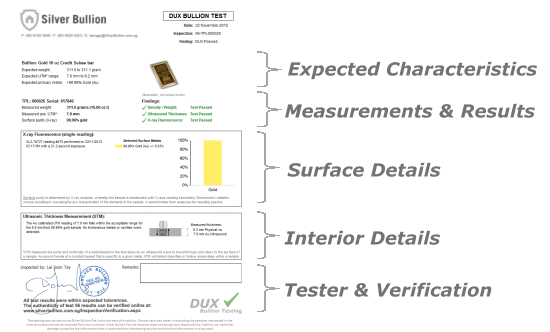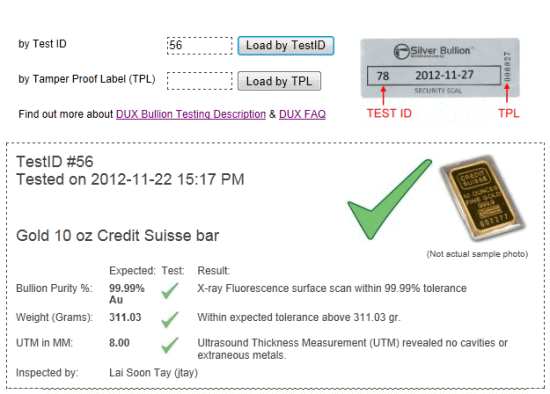Product Details
-
DUX Test
Minimum SGD 55 per session0 gram (0 oz)
Minimum SGD 55 per session-
Any Quantity:Any55.00 SGD
-
DUX Bullion Testing
Fast, Precise and Comprehensive
| DUX is an acronym that stands for Density Ultrasound and X-ray Fluorescence testing. Each test measures and compares a different physical characteristic (mass and volume, ultrasound celerity, and surface metal composition) in such a way that counterfeit bullion might pass an individual test but not the DUX trio of tests. |
Test 1 – “D” for Density / Weight |
|
|
Checking a bullion item’s mass (weight) with its volume (size) is called a density test and is the oldest and most common method to inspect bullion. For example, to check the mass of a silver Mexican Libertad coin, simply place the coin on top of a known good Libertad coin to ensure the diameter matches and then next to each other to ensure the coins’ thickness (height) matches. Then weigh both coins to ensure the mass is the same. Unless you find obvious inconsistencies the coins would have passed the density test. About Volume: Pure silver has a unique weight per unit volume (also called specific gravity/mass) of 10.49 times the weight (for the same volume) of water. Gold’s specific gravity/mass is 19.32 whereas platinum’s specific gravity or mass is 21.40. Thus because gold is 84% denser than silver a 1 troy ounce gold coin will be 84% smaller than a silver coin of the same mass. As 1 liter of water weighs 1 kilogram and occupies 1,000 cm3. It is easy to calculate the volume that the bullion should occupy as we know the specific gravity/mass. For example:
Determining an accurate measurement of volume is a bit complicated if the bullion is irregularly shaped but in practice this is rarely a problem for standard sized investment grade bullion as it can simply be compared to known genuine bullion of the same type. About Weight: Investment Grade bullion should be within a small range above its stated mass because of:
It is also possible for genuine bullion to be slightly below its stated mass due to excessive polishing or excessive scratching which can result in very small mass loss. This is very rate however. So genuine bullion should normally be in a tight range than is at or slightly above the stated weight once adjusted for purity (or alloys). The weight difference, given the same volume, between a gold plated tungsten bar (specific gravity: 19.25) and a genuinepure gold bar (specific gravity: 19.30) is only 0.26%. This small density difference is the reason why tungsten is the preferred metal for counterfeit gold bars. Interestingly Silver is harder to counterfeit using base metals as there is no inexpensive metal whose density is close to silver's 10.49 density. The closest material to silver from a specific gravity perspective is Molybdenum with a specific gravity of 10.19 followed by Bismuth with 9.79 Both of these materials are rare and expensive so nobody would try to fake coins with these materials. The next material closest to silver, lead, has a specific gravity of 11.35 but it is 8% heavier than silver. Copper, a likely material for fakes, has a specific gravity of 8.9 which is 15% lighter than silver. Proper density testing requires precise, accurate scales and a good calibration to adjust for external factors such as altitude (e.g. sea level) which, by itself, can affect weight measurement by as much as 0.5%. If you are doing your own weighting you can avoid many of these calibrations by simply weighting the tested bullion to a genuine item of the same type and look for discrepancies. We use scales whose accuracy and calibration are trade certified by Singapore Weight and Measures Office. We have also invested in advanced electromagnetic force compensation scales which are orders of magnitude more precise, and expensive, than traditional scales. The accuracy and precision of these scales greatly increases the confidence level of test results. |
|
 |
|
Putting it all together - The DUX Bullion Testing System |
|
|
A reliable test standard requires tightly controlled, standardized procedures as well as traceability and a uniformity of testing parameters that do not vary subjectively based on the test operator. The DUX bullion testing system is a set of procedures enforced by custom software that interfaces directly with the DUX testing equipment to offer maximum automation and traceability while minimizing the likelihood of human errors. The basis of DUX are the X-ray spectrometers which, being powerful computers in their own right, store test results in tamper proof onboard memories providing excellent testing traceability. During an inspection the DUX system uploads X-ray spectrometry data directly into the central DUX database along with the spectrometer ID and reading IDs. The operator then specifies the type of bullion that is being tested (e.g. a 10 oz Gold Credit Suisse bar) from our DUX product database which automatically loads the Weight, UTM, Metal and Purity parameters as well as the associated deviation tolerances and physical bullion particularities (e.g. raised bar borders which would affect the UTM vs. Physical Thickness metrics) for the tested bullion. Once the Weight and UTM test results are entered the system then determines whether the results are within our acceptable tolerances and generates the DUX bullion Test Results. This standardization not only creates consistency across inspections but also enforces access control and process traceability by keeping track of “who did what when”. Furthermore DUX test results will be retrievable online so that printed DUX test results can be verified directly with the online DUX database which keeps track of all test parameters as well as checksum and control numbers to detect potential errors or attempts to modify data. To identify and mark the tested bullion we offer our test client the option to use out uniquely ID Tamper Proof Labels (TPLs) to link the tested bullion item with their respective online test results. You can make an appointment via e-mail at [email protected] or call us to schedule for a DUX bullion test or simply visit as a walk in customer with the bullion to be tested. Standard price is 55 SGD and normally takes 10 to 15 minutes to complete.You will receive a DUX Test Result similar to the sample below... |
|
 ... and will also be able to verifiy test results online based on the Test ID or Tamper Proof Label (TPL) number that marks the tested sample:
|
Note: If you paraphrase or copy portions of the above information ensure that you include an origin link back to
this page.



